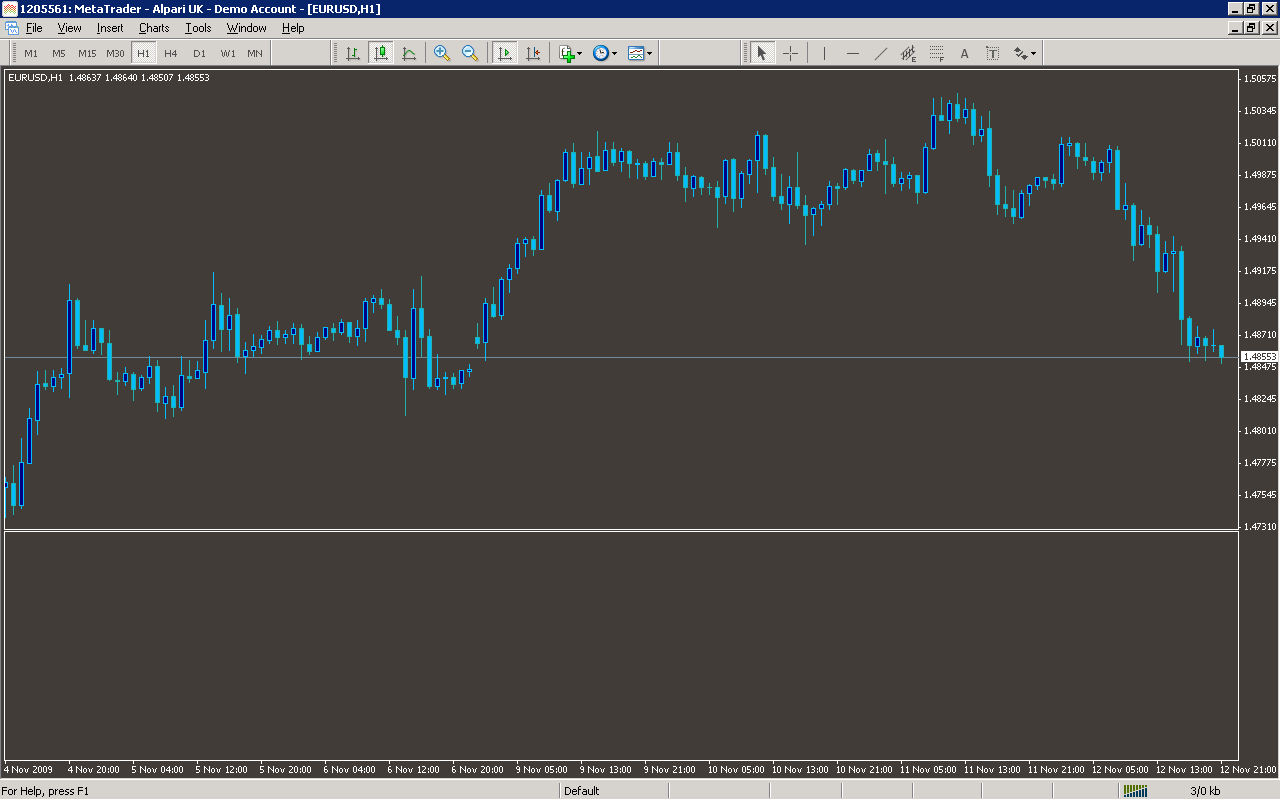//This shows the relative length of the down trend.
//+------------------------------------------------------------------+
//| RelDownTrLen_....mq4 |
//| Author: Martes |
//| http://championship.mql4.com/2007/ru/users/Martes/ |
//+------------------------------------------------------------------+
#property copyright "Martes"
#property link "http://championship.mql4.com/2007/ru/users/Martes/"
//Fix minimum (0) and maximum (1) levels manually. Levels below do not work.
#property indicator_level1 0
#property indicator_level2 1
#property indicator_levelcolor LimeGreen
#property indicator_levelwidth 2
#property indicator_levelstyle 0
#property indicator_separate_window
#property indicator_buffers 1
#property indicator_color1 MidnightBlue
#property indicator_width1 2
extern int barsToProcess=100;
extern int StartingBarNumber=0;
extern bool DrawForCandleBodies=true;
//---- buffers
double ExtMapBuffer1[];
//----
datetime ProcessedTime=0;
double CandleBodyMinimum(int CandleNumber)
{
return(MathMin(Open[CandleNumber], Close[CandleNumber]));
}
double CandleBodyMaximum(int CandleNumber)
{
return(MathMax(Open[CandleNumber], Close[CandleNumber]));
}
// isLeft(): tests if a point is Left|On|Right of an infinite line.
// Input: three points P0=(x0,y0), P1=(x1,y1), and P2=(x2,y2).
// Return: >0 for P2 left of the line through P0 and P1
// =0 for P2 on the line
// <0 for P2 right of the line
double isLeft( double x0, double y0, double x1, double y1, double x2, double y2) {
return( (x1-x0)*(y2-y0) - (x2-x0)*(y1-y0) );
}
//+------------------------------------------------------------------+
//| Custom indicator initialization function |
//+------------------------------------------------------------------+
int init()
{
//---- indicators
SetIndexStyle(0,DRAW_LINE);
SetIndexBuffer(0,ExtMapBuffer1);
//----
return(0);
}
//+------------------------------------------------------------------+
//| Custom indicator deinitialization function |
//+------------------------------------------------------------------+
int deinit()
{
//----
//----
return(0);
}
//+------------------------------------------------------------------+
//| Custom indicator iteration function |
//+------------------------------------------------------------------+
int start()
{
int counted_bars=IndicatorCounted();
//----
int limit;
//Variables for finding best down-trend
int Length, StartIdx, EndIdx,
BestLength=0, BestStartIdx, BestEndIdx;
datetime BestStartTime, BestEndTime;
double BestStartPrice, BestEndPrice;
//Do nothing if the current candle is already processed.
if(ProcessedTime==Time[StartingBarNumber])
{
return(0);
}
else //Process.
{
ProcessedTime=Time[StartingBarNumber];
if(barsToProcess<=2)
{
if(barsToProcess<=1)
{
Print("Too few bars to calculate a down-trend");
return(0);
}
else
{
if(DrawForCandleBodies)
{
BestStartPrice=CandleBodyMaximum(StartingBarNumber+2);
BestEndPrice=CandleBodyMaximum(StartingBarNumber+1);
}
else
{
BestStartPrice=High[StartingBarNumber+2];
BestEndPrice=High[StartingBarNumber+1];
}
if(BestStartPrice<=BestEndPrice)
{
ExtMapBuffer1[0]=0;
Print("No down trend");
return(0);
}
BestStartTime=Time[StartingBarNumber+2];
BestEndTime=Time[StartingBarNumber+1];
}
}
else //Find a Down-Trend with a convex hull.
{
ProcessedTime=Time[StartingBarNumber];
int NumbersOfConvexHullVertices[], //To store indices (numbers) of Vertices in Convex Hull
ConvexHullIdx, //This points to the last valid element of NumbersOfConvexHullVertices
i;
ArrayResize(NumbersOfConvexHullVertices, barsToProcess);
double CandleBodyMaxima[],
x0, y0,
x1, y1,
x2, y2;
ArrayResize(CandleBodyMaxima, barsToProcess);
//Fill array CandleBodyMaxima[] with values from
//the range StartingBarNumber+1 ... StartingBarNumber+barsToProcess of the chart
for(i=1; i<=barsToProcess; i++)
{
if(DrawForCandleBodies)
{
CandleBodyMaxima[i-1]=CandleBodyMaximum(StartingBarNumber+i);
}
else
{
CandleBodyMaxima[i-1]=High[StartingBarNumber+i];
}
}
//Find the lower part of the convex hull for points (i, CandleBodyMaxima[i]) of
//the plane
NumbersOfConvexHullVertices[0]=0;//This is the index of CandleBodyMaxima[0]
ConvexHullIdx=0;//This says that NumbersOfConvexHullVertices[ConvexHullIdx] is valid.
NumbersOfConvexHullVertices[1]=1;//This is the index of CandleBodyMaxima[1]
ConvexHullIdx=1;//NumbersOfConvexHullVertices[ConvexHullIdx] is still thought to be valid.
for(i=2; i<barsToProcess; i++)
{
ConvexHullIdx++;
NumbersOfConvexHullVertices[ConvexHullIdx]=i;//The new point is added in the hull.
//Now we will make the hull convex
x0=NumbersOfConvexHullVertices[ConvexHullIdx-2];
y0=CandleBodyMaxima[NumbersOfConvexHullVertices[ConvexHullIdx-2]];
x1=NumbersOfConvexHullVertices[ConvexHullIdx-1];
y1=CandleBodyMaxima[NumbersOfConvexHullVertices[ConvexHullIdx-1]];
x2=NumbersOfConvexHullVertices[ConvexHullIdx];
y2=CandleBodyMaxima[NumbersOfConvexHullVertices[ConvexHullIdx]];
while( (isLeft(x0, y0, x1, y1, x2, y2)>=0) && (ConvexHullIdx>=2))
{
NumbersOfConvexHullVertices[ConvexHullIdx-1]=NumbersOfConvexHullVertices[ConvexHullIdx];
ConvexHullIdx--;
if(ConvexHullIdx>=2)//Enough points in the hull to process.
{
x0=NumbersOfConvexHullVertices[ConvexHullIdx-2];
y0=CandleBodyMaxima[NumbersOfConvexHullVertices[ConvexHullIdx-2]];
x1=NumbersOfConvexHullVertices[ConvexHullIdx-1];
y1=CandleBodyMaxima[NumbersOfConvexHullVertices[ConvexHullIdx-1]];
x2=NumbersOfConvexHullVertices[ConvexHullIdx];
y2=CandleBodyMaxima[NumbersOfConvexHullVertices[ConvexHullIdx]];
}//if
}//while
}//for
//Find the longest down-trend
for(i=0; i<ConvexHullIdx; i++)
{
StartIdx=NumbersOfConvexHullVertices[i];
EndIdx=NumbersOfConvexHullVertices[i+1];
Length=EndIdx-StartIdx;
if(Length>BestLength &&
CandleBodyMaxima[StartIdx]<CandleBodyMaxima[EndIdx])
{
BestStartIdx=StartIdx;
BestEndIdx=EndIdx;
BestLength=Length;
}//if
}//for
if(BestLength==0)
{
ExtMapBuffer1[0]=0;
Print("No down trend");
return(0);
}
BestStartTime=Time[BestEndIdx+StartingBarNumber+1];
BestEndTime=Time[BestStartIdx+StartingBarNumber+1];
BestStartPrice=CandleBodyMaxima[BestEndIdx];
BestEndPrice=CandleBodyMaxima[BestStartIdx];
}//else //Find an Up-Trend with a convex hull.
ExtMapBuffer1[0]=(1.0*BestLength)/barsToProcess;
// Âàðèàíò: ExtMapBuffer1[0]=BestEndIdx/barsToProcess;
}//else Process
//----
return(0);
}
//+------------------------------------------------------------------+
Sample
Analysis
Market Information Used:
Series array that contains close prices for each bar
Series array that contains open prices of each bar
Series array that contains open time of each bar
Series array that contains the highest prices of each bar
Indicator Curves created:
Implements a curve of type DRAW_LINE
Indicators Used:
Custom Indicators Used:
Order Management characteristics:
Other Features:
